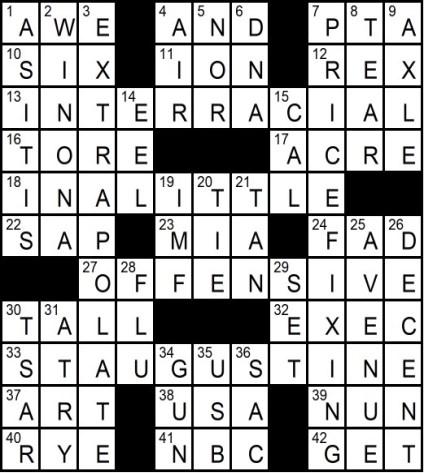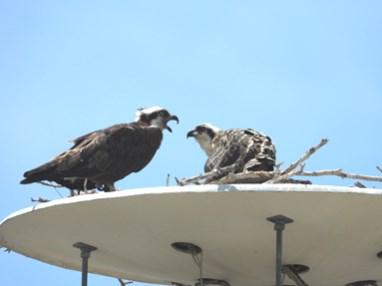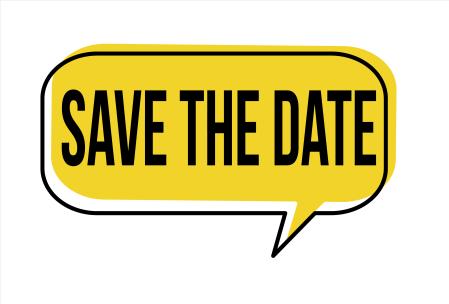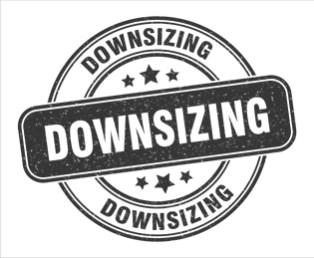
13 minute read
Tamiami Trail
239-695-2682 We are Open Please Call for Hours Adventures of the Saltwater Cowboy - "White Pelicans" Jon Edward Edwards

Advertisement
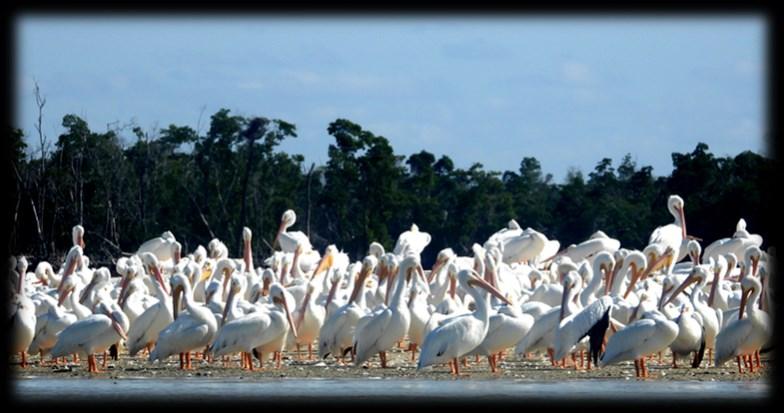


www.captjohnhand.com
She had legs long as day with olive-toned skin; hair sun-kissed at the ends. She could have been a professional tennis player. Maybe she was … It's not like he'd never seen famous people in the Havana Cafe.
He thought of her as he followed the wind trail across the shoal. I can see you, brown skin shining in the sun….
A flock of white pelicans loitered on the lee side of a familiar key as he banked into a grassy depression and shut the engine down. He walked the wake down to the bow and engaged the trolling motor; old school style – no GPS control. The day was beautiful and reminded him of the '90s when the grass was healthier, the trout bigger, and the area less traveled.
He didn't know what about her had him thinking in lyrics, you got the top pulled back, and the radio up, baby … Her devilishly good looks or what she said; with emerald green eyes, in accented English, “I had to come all the way to Florida to find freedom.”
As he meandered through the outer Pavilion Keys, he imagined how it must've looked back in the days of the outlaw Edgar Watson and Everglades City lore and realized it was the latter.
Homeward bound in fading light, her statement was put in perspective. It doesn’t get any freer than this

Jon Edward Edwards is a local author, fishing guide, and avid sportsman. His stories often recount his adventures in and around the 10,000 Islands. Email Jon at jedmls@mac.com.
First Baptist Church
Knowing Him and making Him known!
416 School Drive / P.O. Box 550 Everglades City, FL 34139 Call Us:(239) 695-3871
All-ages Sunday School: 9:45 a.m. Sunday Worship: 11:00 a.m. & 6:00 p.m. Wednesday Worship: 6:00 p.m.

At Win-Car Hardware We Have Just About Everything Unique Apparel, Nav Charts.
Fishing Tackle, Camping, Biking, Hiking, Gifts, Books, Souvenirs, Marine Hardware, Stainless & More!
209 Collier Ave, Everglades City M-Sat 8:30 am - 5 pm. 239-695-3201 Open Daily: 10:30 am – 5:00 pm
Standard Rooms Balcony Rooms
DAILY WEEKLY MONTHLY
102 E. Broadway Everglades City, FL For Reservations: 239-695-1011
New Community Assistance Program will help residents and small business owners impacted by COVID-19. Aid is available for some past due bills and more. Collier County residents and business owners impacted by COVID-19 may receive financial aid to pay for past due bills and more. The County will opened its new Collier Community Assistance Program (CCAP) on March 29. Payment assistance is available for households behind on mortgage, rent and utility bills. Small business owners, nonprofits and agricultural operations behind on utility payments and/or need to repay the Economic Injury Disaster Loan (EIDL) may also qualify for aid.
The financial relief program will be open on an ongoing basis this year or until funds are depleted, whichever one occurs first. Past due bills must have accumulated as the result of COVID-19 and must be documented. Income and other eligibility requirements may apply. Assistance is available on a first-come, first qualified basis. Food banks and pantries may also apply for assistance by reaching out to the Community Foundation of Collier County.
Aid is available for households with past due bills going back (arrearage) to March 13, 2020. Applicants must have been current on their rent or mortgage on March 13, 2020. Arrearage is available up to a maximum of $10,000 for rent, mortgage and utility relief for those in CCAP. However, applicants will also be screened for benefits through the Emergency Rental Assistance (ERA) program, which does not have a cap on funds and only assists with arrearage and future rent payments. Applicants should be aware that if they qualify for ERA, they will have to re -qualify every three months to continue to receive payment assistance.
Small businesses, nonprofits and agricultural operations must qualify by being in Collier County, with a business tax license, hold a Sunbiz registration, and employ 100 or less full-time equivalent (FTE) staff. Applicants should select small business during the application process.
Business owners that own more than one business, with each business having its own employer identification number (EIN) and meets all other eligibility requirements, may apply for assistance for each business. An application must be submitted for each business. For past due water and electric bill assistance, the utility account must be in the name of each business. Each qualified applicant may receive a one-time grant of up to $25,000 toward EIDL repayment and utility assistance. Since this is a grant and not a loan, it does not need to be paid back.
More specific information is available at CollierFLAssistance.com or at 13245 Tamiami Trail East, Suite 102, in Naples.
Appointments are required. (239) 450- 2114 to set up an appointment or email CCAPinfo@colliercountyfl.gov to set up an appointment or more information. Remember to wear a mask to your appointment, please.
Study Finds Glyphosate in More Than Half of All Sampled Florida Manatees Submitted by The Center for Biological Diversity
A scientific study published this week concludes that Florida manatees are chronically exposed to glyphosate because of application of the pesticide to sugarcane and aquatic weeds.
The study found glyphosate, the active ingredient in Roundup and the world’s most-used pesticide, in the plasma of 55.8% of the Florida manatees sampled. The concentration of glyphosate in plasma has increased from 2009 to 2019.
Additionally, the study’s authors determined that glyphosate concentrations in the Caloosahatchee and St. Lucie rivers and Everglades Agricultural Area stormwater treatment areas were significantly higher before and during sugarcane harvesting, when glyphosate is more likely to be applied, than after harvest.
“Manatees are Exhibit A that Florida’s waters are in crisis and they shouldn’t be facing this kind of pesticide threat,” said Jaclyn Lopez, Florida director of the Center for Biological Diversity. “Our beloved, chubby sea cows are dodging boat strikes, reeling from red tide and starving in the Indian River Lagoon because of water pollution. It’s heartbreaking to add chronic glyphosate exposure to the list of factors threatening manatee survival.”
“The results of this recent study are cause for serious concern about the chronic use, fate and effects of glyphosate on the manatee population in south Florida,” said John Cassani of Calusa Waterkeeper. “An increasing trend for glyphosate in manatee plasma that correlates with concurrent increased usage of glyphosate is disturbing, especially at a time when manatee mortality is at very high levels. The authors report the same level of glyphosate exposure that manatees experience, causes kidney and liver damage in laboratory animals.”
The study found that the amount of glyphosate sprayed by the Florida Fish and Wildlife Conservation Commission to control aquatic weeds in Lake Okeechobee exceeded the sample waters, reaching up to 10,000 kilograms per year, and that the Army Corps’ Lake Okeechobee discharges result in high concentrations of glyphosate in the Caloosahatchee and St. Lucie rivers.
The study, published in Environment International, also found that manatees were exposed to glyphosate in non-agricultural areas, such as the Crystal River, and that exposure was higher during winter, when manatees depend on the warm water refuge. The study concluded that the chronic exposure in Florida water bodies may have consequences for Florida manatees’ immune and renal systems, which may be further compounded by other environmental factors, such as red tide or cold stress.
Glyphosate is the most widely used herbicide, with about 280 million pounds a year used across 285 million acres in agriculture alone. Its total volume of application has increased by a factor of 12 from 1995 to 2014. The EPA recently determined that glyphosate’s labeled uses are likely to adversely affect 93% of all listed species and 96% of critical habitats, including the Florida manatee.
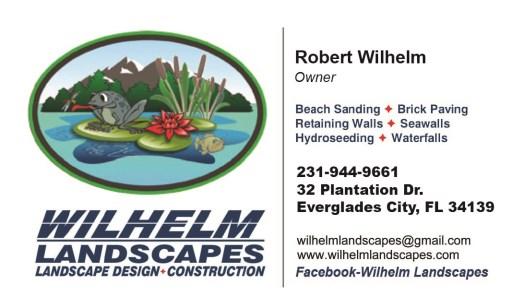
Parkway Motel & Marina
(239) 695-3261
Rental Rooms, Efficiencies & 2/2 Cottage
1180 Chokoloskee Dr., Chokoloskee, FL www.parkwaymotelandmarina.net
Valvtect Marine,
Rec 90 gas at the dock
Dock water & electric Boat lift, Ice
Removing the cork in the bottle: Reconstructing Tamiami Trail to restore water flow to Everglades National Park By Antonia Florio, Science Communications Liaison, Everglades National Park
It’s April 26, 1928, and the two-lane Tamiami Trail is finally complete. For the first time ever, people can travel easily by car from Tampa to Miami, hence the name Tamiami.
How did engineers get it done? Time, money and explosives. Also known as U.S. Highway 41, Tamiami Trail was considered a feat of engineering at the time. It took over 11 years and cost $7 million to complete the 264-mile roadway. The builders used approximately 3 million sticks of dynamite in Collier County alone to create the canal adjacent to the highway and to provide the dirt fill to construct the roadway.
The road was great for the economy of Southwest Florida and allowed this part of Florida to become a center for real estate, business, and tourism.
It was disastrous for the Everglades ecosystem.
Specifically, the 25-mile stretch of the road heading east to west acted as a dam. It blocked the natural downward flow of the “River of Grass,” holding back water from the plants and animals that desperately needed it to survive.
The negative effects on the Everglades ecosystem were recognized early. Beginning in the 1940s, a series of bridges, culverts, and conveyance structures were added to help prevent flooding and improve water flow.
These weren’t complete fixes, and the eastern 10.7-miles, located between the L-31N and L-67 Extension levees, still greatly limited the amount of water that could flow into Northeastern Shark River Slough.
This part of Tamiami Trail was so low that it was impossible to raise water levels high enough in the adjacent L-29 canal to allow water to flow into the park without it flooding and damaging the road.
Water levels continued to drop south of the road. Because it was now drier than it should be, there were more wildfires and there were more exotic plants. The ecosystem continued to decline.
But there’s a happy ending to this story. Starting in 1989, with follow-up efforts in 2009, Congress authorized a comprehensive plan that, although costly, aimed to finally fix the water flow problem created by the Tamiami Trail. The connection between southeastern and southwestern Florida would remain. An elevated one-mile bridge was completed in 2013, and 2.3 -miles of bridging was completed in 2019. Engineers and park managers put a lot of thought into these bridges. They lined up each bridge with historic sloughs, or low-lying areas naturally found in the Everglades, to allow the maximum amount of flow under them and to get the water further south as quickly and easily as possible.
They cut costs and gave drivers a glimpse into the Everglades by “super elevating” the north side of the bridge. This allowed them to spend less money on drainage structures since the road now sloped downward, and it gave many people their first, and perhaps only, window into the River of Grass as they drove by.
What the engineers and park managers didn’t expect was for it to work so well. By building this approximately 3.5-miles of bridging, they were able to increase the flow of water into the park by 80%, more than they anticipated.
The project was only midway complete when they realized they didn’t need more flow, but instead the water needed to be distributed across the Everglades better.


“We did an analysis of the flow under the bridges and found that adding more bridging didn’t increase water flow that much more,” said Charles Borders, who was the National Park Service lead and former project manager on the Tamiami Trail Next Steps Project. “For about half of the money, we could add in culverts which would solve the distribution problem as well.”
With those surprise findings, they changed course and instead of adding more bridges, they started to plan where to add in more costfriendly culverts, or tunnels that allow water to flow under the Trail. The remaining 6.7-miles of the eastern Tamiami Trail will be reconstructed with additional culverts, in historic sloughs when possible, and with more structures for roadway safety and stormwater treatment. The entire project will finally be completed by 2024. We are already seeing some promising results as water is now flowing more freely. This year we’ve seen high water levels throughout the park, definitely helped by high rainfall, but undoubtedly also facilitated by the completion of the bridges on the Tamiami Trail. “The Tamiami Trail project will allow restoration to move forward in the park,” said Amy Renshaw, hydrologist at Everglades National Park. “We couldn't put the additional water that is necessary for restoration into the park without the roadway work. It removes an approximately 100-year impairment to water flow and will help with endangered species issues by directing water where it's supposed to go.”
Engineers may have made a mistake with the first road, but they’ve fixed it. The metaphorical cork in the Everglades bottle is out: Bring on the water!
Photos: Top left, the archway on the border of Collier and Dade County from opening day of the Trail on 4-26-28.
Bottom left: A photo of the elevated one-mile bridge completed in 2019. NPS photo.
Top right: Culverts are now the focus of the last steps in the Tamiami Trail Project. Culverts are cheaper to build than bridges, so engineers can put more of them along the Tamiami Trail to help distribute water through the Everglades in a way more similar to how it was distributed historically. NPS photo by Vincent DiFrenna
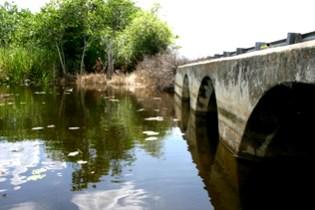
The Mullet Rapper Supports the Everglades Community and School Each year, The Mullet Rapper hosts plant sales, and other events, to raise money for Everglades City School. Please help us support our local children by attending one of our school fundraiser events!

Shop Amazon and Give to a Local Charity at No Extra Cost to You. Here’s How - in Just a Click! (This can be done all year long)
If you shop on Amazon, at no additional cost to you, you can support a local charity. Three (that we have been made aware of) have been set up for charities in the Everglades area. All you need to do is click on the link and accept the charity and Amazon does the rest. Below, the links are provided:
Everglades Society for Historic Preservation: smile.amazon.com/ch/20-2229534
Everglades Lions Foundation: https://www.amazon.com/b? node=15576745011
Everglades Community Church https://smile.amazon.com/ch/22-3934843
If you have a charity that is set up on Amazon, let us know so we can promote the link in the Mullet Rapper!
Contact us by email at mulletrapper@gmail.com Call us at: 954-662-7003



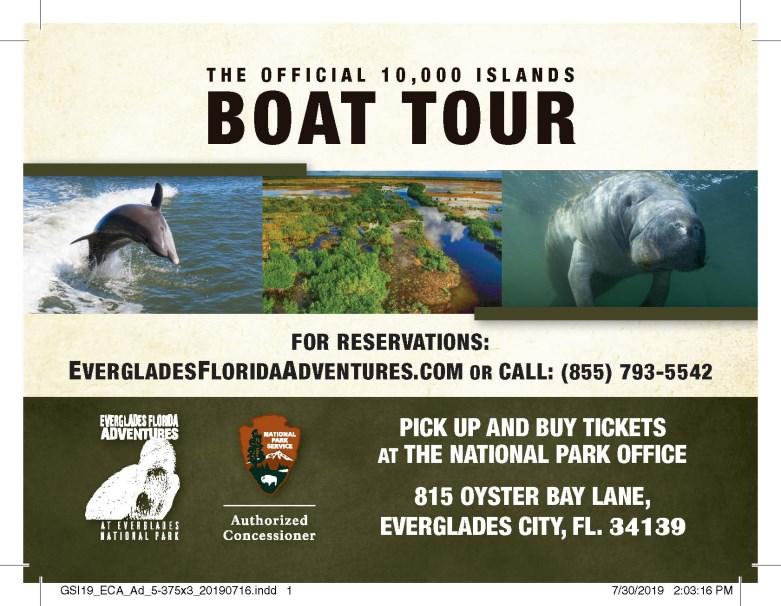

Solution to March 20, 2021 Puzzle
